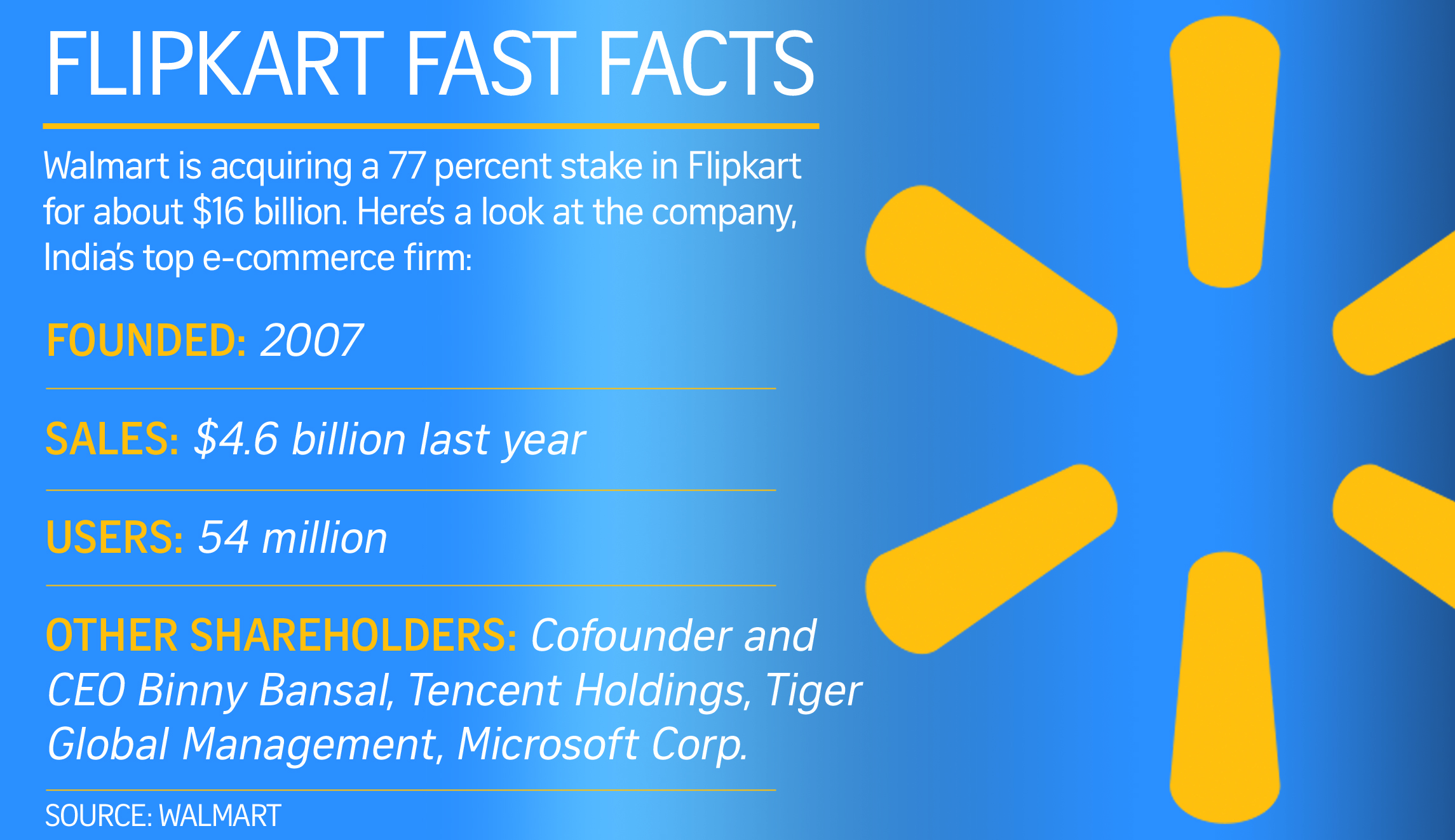For two of the biggest U.S. retailers, one of the most important battlegrounds in the struggle for dominance is on the other side of the globe.
Both Walmart, with a foundation in bricks-and-mortar stores, and Amazon, which built a fortune in e-commerce, are executing aggressive expansion plans in India, whose population of 1.28 billion makes it the second largest nation in the world.
Walmart’s recent $16 billion purchase of a majority stake in India’s biggest e-commerce site is the retail behemoth’s most significant foray into the country to-date and puts renewed pressure on Amazon, even as each firm builds a more muscular presence in what has been its rival’s key strength.
Amazon has made a string of major purchases and formed partnerships to offer physical sites in key U.S. markets, while Walmart remains the largest U.S. retailer and, despite struggling to grow its online offerings, has made significant acquisitions to bolster its e-commerce business.
The expansion strategies of both companies illustrate the increasing pressure on businesses to adapt to the “whatever, whenever” mentality of consumers, particularly millennials who came of age in a Web-based environment.
“Everybody’s going to move to this omnichannel environment, some combination of physical and online,” Barbara Kahn, professor of marketing at the Wharton School of the University of Pennsylvania, said in an interview. “It’s just going to be what happens everywhere.”
Walmart’s acquisition of a majority stake in Flipkart, Amazon’s most significant rival in India, signals a new stage in the global fight. The country represents a major growth opportunity for both companies, but a difficult regulatory environment has slowed expansion.
“India has been a battleground for e-commerce for a number of years now, and a lot of it has been stifled by the regulation in India,” said Rajiv Kohli, a business professor with the Raymond A. Mason School of Business at William & Mary. “There’s a huge potential there. But the problem that I think both these companies will have, perhaps to a lesser extent Walmart now with Flipkart, is understanding the local customer.”
Amazon already holds a roughly 30 percent share of the Indian market and reportedly made its own bid for Flipkart, which controls a similar portion.
Such a deal would probably have drawn heightened scrutiny from regulators already skittish over the anticompetitive risk posed by Amazon, and the speculation around it shows just how nervous the Seattle-based e-retailer is about Walmart’s entry.
“No one had been really making any money in the India e-commerce market — even right now [Amazon is] not profitable,” said Dan McCarthy, an assistant professor of marketing at Emory University. “This acquisition just pushes out that timeline to profitability even further because now they have a competitor who has much deeper pockets.”

Amazon’s international sales grew 23 percent to $13.9 billion in the first three months of this year, though the company didn’t break out data for India and declined to comment for this article.
Walmart is likely to experience growing pains in the country, too. The Bentonville, Ark.-based company has had difficulty entering other markets and recently retreated from some of its global growth plans. It sold the majority of its U.K. supermarket business to rival Sainsbury and scaled back operations in Brazil, but says it’s committed to India.
“We’ve been operating in India since 2009, and we’re very encouraged by the progress we’re seeing,” Chief Executive Officer Doug McMillon said. “With this investment, we’re pleased to be making a long-term investment in India’s future.”
Further complicating matters, is the fact that Walmart and Amazon have more to worry about than each other. Chinese e-commerce giant Alibaba Group has also invested in several businesses in India, including Paytm, the country’s first digital-payment company. Additionally, Alibaba recently became the largest shareholder in BigBasket, India’s leading online grocer, after a $146 million investment.
And Walmart’s overall strategy has its share of skeptics. Some industry experts have questioned the prices Walmart paid for both Flipkart and startup Jet.com, a $3.3 billion acquisition that honed the retailer’s edge in U.S. e-commerce.
In its most recent quarterly earnings statement, the company reported that e-commerce revenue growth slowed to 44 percent from 69 percent a year ago. A crucial challenge is the growing focus on customized shopping, an area where Amazon has an advantage with its wildly popular Prime service, whose price was recently raised to $119 a year.
Walmart hasn’t yet reached its potential in catering to individual customers, McCarthy said. “As they continue to grow their ability to tag and track customers, it’s going to be easier and easier for them to pursue that.”
The company does have advantages elsewhere, though. Estimates have shown most U.S. residents live within 15 miles of a Walmart store, and Walmart’s expanded online offerings, such as in-store pickup, help drive business back to the brick-and-mortar locations.
The company reported a 1.6 percent increase in U.S. in-store traffic and a 2.6 increase in sales to $87 billion for the three months through Jan. 26.
“U.S. customers that shop us in-store and online spend nearly twice as much as customers that only shop with us in stores,” McMillon said recently.

